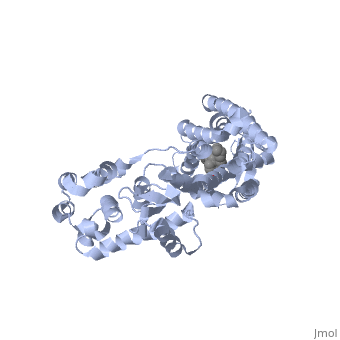4ej4
From Proteopedia
Structure of the delta opioid receptor bound to naltrindole
Structural highlights
FunctionENLYS_BPT4 Endolysin with lysozyme activity that degrades host peptidoglycans and participates with the holin and spanin proteins in the sequential events which lead to the programmed host cell lysis releasing the mature viral particles. Once the holin has permeabilized the host cell membrane, the endolysin can reach the periplasm and break down the peptidoglycan layer.[1] OPRD_MOUSE G-protein coupled receptor that functions as receptor for endogenous enkephalins and for a subset of other opioids. Ligand binding causes a conformation change that triggers signaling via guanine nucleotide-binding proteins (G proteins) and modulates the activity of down-stream effectors, such as adenylate cyclase. Signaling leads to the inhibition of adenylate cyclase activity. Inhibits neurotransmitter release by reducing calcium ion currents and increasing potassium ion conductance. Plays a role in the perception of pain and in opiate-mediated analgesia. Plays a role in developing analgesic tolerance to morphine.[2] [3] [4] Publication Abstract from PubMedThe opioid receptor family comprises three members, the micro-, delta- and kappa-opioid receptors, which respond to classical opioid alkaloids such as morphine and heroin as well as to endogenous peptide ligands like endorphins. They belong to the G-protein-coupled receptor (GPCR) superfamily, and are excellent therapeutic targets for pain control. The delta-opioid receptor (delta-OR) has a role in analgesia, as well as in other neurological functions that remain poorly understood. The structures of the micro-OR and kappa-OR have recently been solved. Here we report the crystal structure of the mouse delta-OR, bound to the subtype-selective antagonist naltrindole. Together with the structures of the micro-OR and kappa-OR, the delta-OR structure provides insights into conserved elements of opioid ligand recognition while also revealing structural features associated with ligand-subtype selectivity. The binding pocket of opioid receptors can be divided into two distinct regions. Whereas the lower part of this pocket is highly conserved among opioid receptors, the upper part contains divergent residues that confer subtype selectivity. This provides a structural explanation and validation for the 'message-address' model of opioid receptor pharmacology, in which distinct 'message' (efficacy) and 'address' (selectivity) determinants are contained within a single ligand. Comparison of the address region of the delta-OR with other GPCRs reveals that this structural organization may be a more general phenomenon, extending to other GPCR families as well. Structure of the delta-opioid receptor bound to naltrindole.,Granier S, Manglik A, Kruse AC, Kobilka TS, Thian FS, Weis WI, Kobilka BK Nature. 2012 May 16;485(7398):400-4. doi: 10.1038/nature11111. PMID:22596164[5] From MEDLINE®/PubMed®, a database of the U.S. National Library of Medicine. See AlsoReferences
| ||||||||||||||||||||

